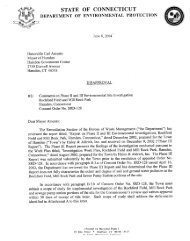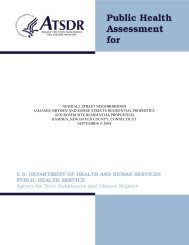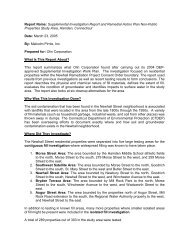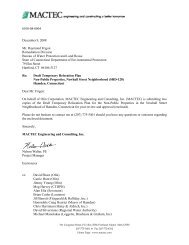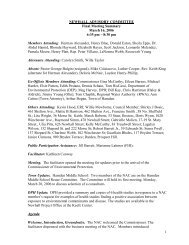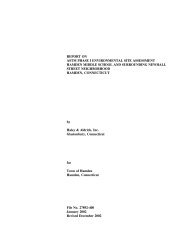Remedial Action Plan - Rochford Field - Newhall Remediation Project
Remedial Action Plan - Rochford Field - Newhall Remediation Project
Remedial Action Plan - Rochford Field - Newhall Remediation Project
You also want an ePaper? Increase the reach of your titles
YUMPU automatically turns print PDFs into web optimized ePapers that Google loves.
On-site soil washing<br />
Bioremediation or land farming<br />
On-site or off-site thermal desorption or incineration<br />
In-situ solidification or stabilization.<br />
The remedial “Alternatives” which were considered as part of the RAP evaluation included:<br />
<br />
<br />
<br />
<br />
Alternative 1 – Complete excavation of all fill material on site that exceeds regulatory criteria:<br />
All material that exceeds RDEC and/or PMC would be excavated to an average depth of<br />
approximately 8 ft. and either temporarily stockpiled on site or loaded directly into trucks for<br />
transportation for off-site disposal (permitted landfill or other no-cost disposal alternative<br />
approved by CTDEEP.) In addition to the average thickness of 2 ft of earthen fill, we assume<br />
that an average contaminated fill thickness of 6.0 ft at <strong>Rochford</strong> <strong>Field</strong> exceeds RDEC and<br />
PMC. The contaminated fill must be disposed of at a permitted landfill. Clean fill would need<br />
to be imported to the site to offset the volume of material being disposed of offsite.<br />
Groundwater would be addressed via natural attenuation groundwater monitoring.<br />
Alternative 2 – Excavation of upper 4 ft of fill material: This option would be used in order to<br />
render remaining soil (below a depth of 4 ft) that exceeds the RDEC inaccessible, would use<br />
variances or alternative criteria to address soil exceeding PMC. All material to a depth of 4 ft<br />
would be excavated and either temporarily stockpiled on site or loaded directly into trucks for<br />
transportation for off-site disposal (permitted landfill or other no-cost disposal alternative<br />
approved by CTDEEP.) In addition to the average thickness of 2 ft of earthen fill, it was<br />
assumed that the remainder of the contaminated fill to the depth of 4 ft also exceeds the RDEC.<br />
Clean fill would need to be imported to the site to offset the volume of material being disposed<br />
of offsite. Upon completion of the work, an ELUR would be recorded on the land records.<br />
Groundwater would be addressed via natural attenuation groundwater monitoring.<br />
Alternative 3 – Excavation of upper 2 ft of fill material and installation of an asphalt cap: This<br />
option would be used in order to render remaining soil (below a depth of 2 ft) that exceeds the<br />
RDEC inaccessible, would use variances or alternative criteria to address soil exceeding PMC.<br />
All material to a depth of 2 ft would be excavated and either temporarily stockpiled on site or<br />
loaded directly into trucks for transportation for off-site landfill disposal and or recycling. It<br />
was assumed that all fill to a depth of 2 ft exceeds the RDEC. Clean fill would need to be<br />
imported to the site to offset the volume of material being disposed of off-site. The clean fill<br />
and a 6 in. layer of processed aggregate would be covered with a minimum 3 in. thick paved<br />
surface. The paved surface would also require the installation of storm drains, and potentially<br />
additional storm water management facilities, to control the additional surface water runoff.<br />
Upon completion of the work, an ELUR would be recorded on the land records. Groundwater<br />
would be addressed via natural attenuation groundwater monitoring.<br />
Alternative 4 – Installation of a 2 ft thick engineered cap placed on the ground surface and<br />
designed in accordance with the RSRs: The RSRs allow placement and maintenance of a<br />
CTDEEP-approved engineered control as a means to achieve RSR compliance. The engineered<br />
control would consist of an impermeable HDPE membrane and drainage system to be installed<br />
over the contaminated soil. The membrane would be underlain by a 6 in. “cushion” layer of<br />
imported sand or screened earthen fill, and covered by a 12 in. layer of imported sand. The<br />
12



